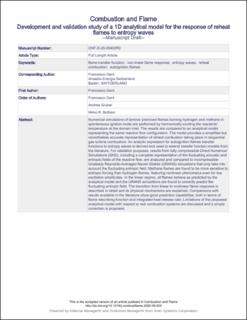| dc.contributor.author | Gant, Francesco | |
| dc.contributor.author | Gruber, Andrea | |
| dc.contributor.author | Bothien, Mirko R. | |
| dc.date.accessioned | 2020-11-12T14:01:03Z | |
| dc.date.available | 2020-11-12T14:01:03Z | |
| dc.date.created | 2020-09-21T15:02:17Z | |
| dc.date.issued | 2020 | |
| dc.identifier.citation | Combustion and Flame. 2020, 222 305-316. | en_US |
| dc.identifier.issn | 0010-2180 | |
| dc.identifier.uri | https://hdl.handle.net/11250/2687652 | |
| dc.description.abstract | Numerical simulations of laminar premixed flames burning hydrogen and methane in spontaneous ignition mode are performed by harmonically exciting the reactants’ temperature at the domain inlet. The results are compared to an analytical model representing the same reactive flow configuration. The model provides a simplified but nevertheless accurate representation of reheat combustion taking place in sequential gas turbine combustors. An analytic expression for autoignition flames transfer functions to entropy waves is derived and used to extend transfer function models from the literature. For validation purposes, results from fully compressible Direct Numerical Simulations (DNS), including a complete representation of the fluctuating acoustic and entropic fields of the reactive flow, are analyzed and compared to incompressible Unsteady Reynolds-Averaged Navier–Stokes (URANS) simulations that only take into account the fluctuating entropic field. Methane flames are found to be more sensitive to entropic forcing than hydrogen flames, featuring nonlinear phenomena even for low excitation amplitudes. In the linear regime, all flames behave as predicted by the analytical model and the URANS simulations are found to correctly predict the fluctuating entropic field. The transition from linear to nonlinear flame response is described in detail and its physical mechanisms are explained. Comparisons with results available in the literature show good prediction capabilities, both in terms of flame describing function and integrated heat release rate. Limitations of the proposed analytical model with respect to real combustion systems are discussed and a simple correction is proposed. | en_US |
| dc.language.iso | eng | en_US |
| dc.publisher | Elsevier | en_US |
| dc.rights | Attribution-NonCommercial-NoDerivatives 4.0 Internasjonal | * |
| dc.rights.uri | http://creativecommons.org/licenses/by-nc-nd/4.0/deed.no | * |
| dc.title | Development and validation study of a 1D analytical model for the response of reheat flames to entropy waves | en_US |
| dc.type | Peer reviewed | en_US |
| dc.type | Journal article | en_US |
| dc.description.version | acceptedVersion | en_US |
| dc.source.pagenumber | 305-316 | en_US |
| dc.source.volume | 222 | en_US |
| dc.source.journal | Combustion and Flame | en_US |
| dc.identifier.doi | 10.1016/j.combustflame.2020.09.005 | |
| dc.identifier.cristin | 1831757 | |
| dc.relation.project | EC/H2020/765998 | en_US |
| dc.relation.project | Norges forskningsråd: 257579 | en_US |
| dc.relation.project | Notur/NorStore: nn9527k | en_US |
| cristin.ispublished | true | |
| cristin.fulltext | postprint | |
| cristin.qualitycode | 2 | |

